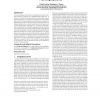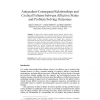1623 search results - page 24 / 325 » Collaborative Problem Solving Environment |
ATAL
2007
Springer
14 years 3 months ago
2007
Springer
This paper addresses the problem of identifying the value of information held by a teammate on a distributed, multi-agent team. It focuses on a distributed scheduling task in whic...
ETS
2000
IEEE
13 years 8 months ago
2000
IEEE
Practice has shown that providing content to students alone is not sufficient for good learning results. In computer based training (CBT) and especially webbased training (WBT) en...
AIED
2009
Springer
14 years 24 days ago
2009
Springer
We explored the complex interplay between students' affective states and problem solving outcomes. We conducted a study where 41 students solved 28 analytical reasoning proble...
OPODIS
1997
13 years 10 months ago
1997
Unreliable fault detectors can be used to solve the consensus problem in asynchronous distributed systems that are subject to crash faults. We extend this result to asynchronous d...
CIA
1999
Springer
14 years 1 months ago
1999
Springer
Abstract. Evaluations of distances or similarity measurements are very important in cooperative problem solving with multiple agents. Distance between problems is used by agents to...



